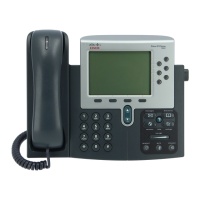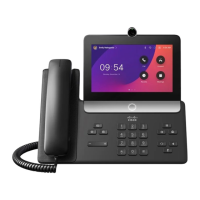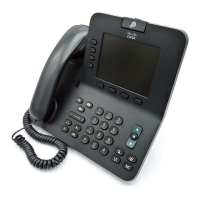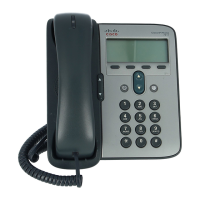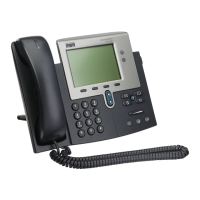2-4
Cisco SIP IP Phone Administrator Guide
Chapter 2 Getting Started with Your Cisco SIP IP Phone
Installing the Cisco SIP IP Phone
The SIP parameters are those parameters that a Cisco SIP IP phone needs to operate in a SIP VoIP
environment. You can configure SIP parameters via a TFTP server, or you can manually configure the
parameters on a phone-by-phone basis after connecting the phones.
When the phone initializes, it loads the parameters stored in Flash memory. After loading the parameters
stored in Flash memory, the phone requests the default configuration file from the TFTP server. If the
default configuration file has been configured and stored in the root directory of the TFTP server, the
phone reads the parameters defined in the file, and stores those parameters that differ in Flash memory.
The phone then requests its phone-specific configuration file. If the phone-specific configuration file has
been configured and placed on the TFTP server (in the root directory or a subdirectory), the phone reads
the parameters defined in the file and stores those parameters that differ in Flash memory.
Therefore, when configuring SIP parameters, remember the following:
• Parameters defined in the default configuration file override the values stored in Flash memory.
• Parameters defined in the phone-specific configuration file override the values specified in the
default configuration file.
• Parameters entered locally are used by the phone until the next reboot (if a phone-specific
configuration file exists).
• If you choose not to configure the phone via a TFTP server, you must manage the phone locally.
Configuring SIP Parameters via a TFTP Server
If you are configuring SIP parameters via a TFTP server, you must use configuration files.
There are two configuration files that you can use to define the SIP parameters; the default configuration
file (optional) and the phone-specific configuration file (required). If you choose to use a default
configuration file, you must store the file in the root directory of your TFTP server. Phone-specific
configuration files can be stored in the root directory or in a subdirectory in which all phone-specific
configuration files are stored.
Except for parameters used to define the lines and users on a phone, all other SIP parameters can be
defined in either the default configuration file or the phone-specific configuration file. However, for
network control and maintenance purposes, we recommend that you define the parameters that you want
to apply to all phones in the default configuration file (SIPDefault.cnf). Phone-specific parameters
should only be defined via a phone-specific configuration file or be manually configured. Phone-specific
parameters should not be defined in the default configuration file.
Configuration File Guidelines
When modifying the default configuration file and creating the phone-specific configuration files,
adhere to the following guidelines and requirements:
• SIP parameters specified in the default configuration file (SIPDefault.cnf) override those parameters
stored in Flash memory. Parameters specified in a phone-specific configuration file override those
stored in Flash memory and parameters specified in the default configuration file.
• The name of each phone’s phone-specific configuration file is unique and is based on the MAC
address of the phone.
The format of the file name must be SIPXXXXYYYYZZZZ.cnf, where XXXXYYYYZZZZ is the MAC
address of the phone. The MAC address must be in uppercase, and the cnf extension must be in
lowercase (for example, SIP00503EFFD842.cnf).
